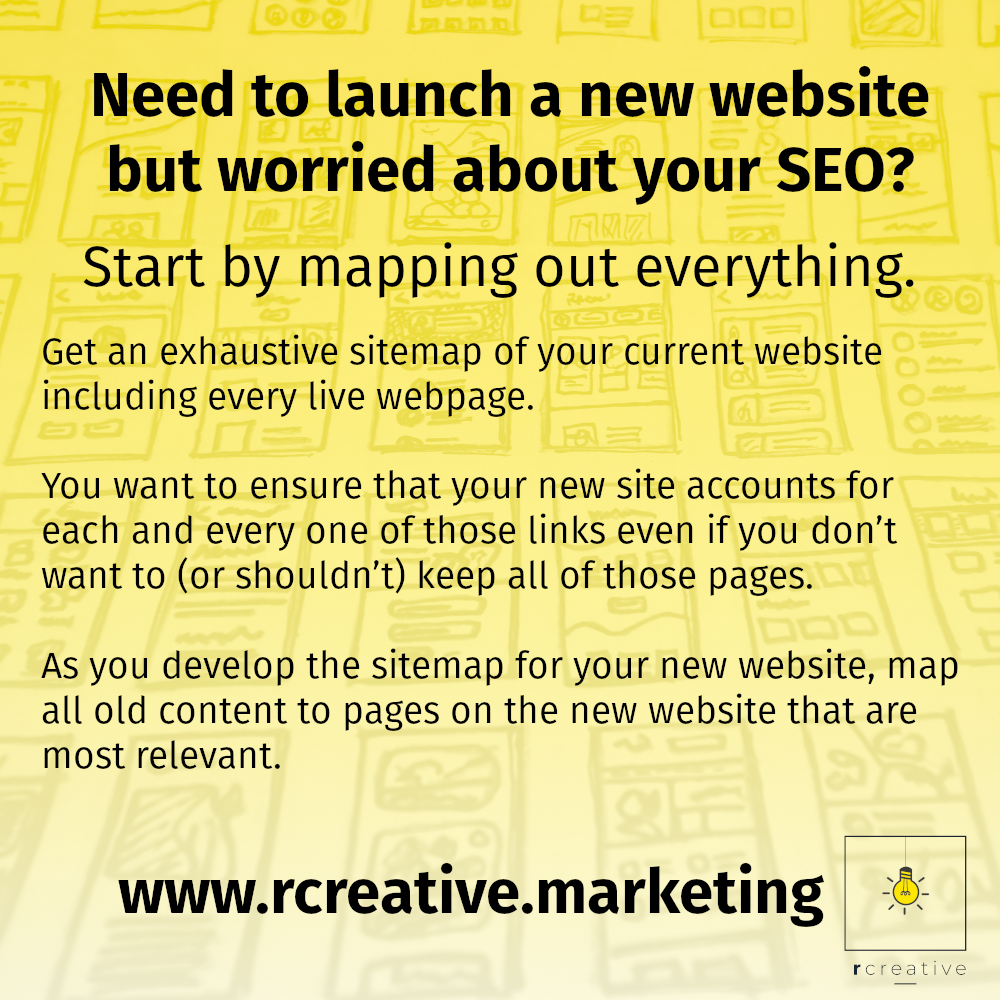So your business’ website has been around for a while. It’s working for you but the constant bug fixes, time consuming work flows, and janky compatibility with other software is driving your Marketing Department crazy.
Relate?
You’re not alone. That is a common situation many Marketing Managers and business executives find themselves in as an established business grows.
It is at just this moment that you start entertaining launching a new website and selling that idea to the company.
Until you remember your awesome search engine rankings and organic traffic.
How on earth will you maintain those numbers if you launch a new website? The possibility of losing traffic is just too scary to launch that new website now.
But wait! Don’t punt forever. Yes, you can launch a new website without destroying your search engine position.
Here are 7 things you can do to help ensure you keep your search engine rankings after launching a new website:
1. Map Out Everything

Get an exhaustive sitemap of your current website including every live webpage. You may be surprised by what you find.
You want to ensure that your new site accounts for each and every one of those links even if you don’t want to (or shouldn’t) keep all of those pages.
As you develop the sitemap for your new website, map all old content to pages on the new website that are most relevant.
This important planning step ensures that no page link is missed.
Don’t skip this.
2. 301s
Before launching your new website, have your web development team create a 301 redirect list for every page link from the old site that is changing or being removed. Each old link should automatically redirect to a relevant page on the new site. The more relevant the better.
This step combined with your initial planning helps ensure that no links are broken when you go live – retaining important backlinks and maintaining old traffic.
You can help reduce the work and risk involved here by launching a new website with identical page structure to the old one. Yet there is a risk/reward balance to evaluate here. If you have poor pages hurting your SEO on the old site, redirecting them to better ones may not hurt. More importantly, if your old site is bloated and has multiple pages focused on the same keyphrases you may be cannibalizing your search engine traffic. Combining and reorganizing for particular market segments with appropriate keyphrase research may give you long term search engine gains.
3. Consider Not Changing Your Best Performing Pages
If you have value added content like blog posts, landing pages, or downloadable resources that are just killing it in search engine traffic consider leaving those as unchanged as possible.
If you leave the content virtually identical to the old site, retain link structure, and improve other SEO factors on those pages you should not see a lasting dip in traffic after taking the new site live – you may even see an increase for those pages.
Your homepage is an exception. This page is nearly always the top performing page just by virtue of being your homepage. If you can improve its content, design, and marketing flow – do it.
4. Test, Stage, Plan Your Go-Live
Too often businesses take the right steps to retain SEO with a website rebuild but fall down in go-live planning.
A poor website launch can lead to:
- Downtime
- Unexpected bugs
- Poor mobile optimization
- Slow site speed
- Unusable contact forms
- And more
Downtime, bugs, and poor optimization can all hurt your search engine rankings. An otherwise well planned website launch can seriously hurt your search engine rankings if it is not executed well.
How will your new website be developed, tested, and taken live?
Answer those questions now – not later.
Test your new website in an environment similar to your live website and test on all common device types.
Have your web development team thoroughly comb the site for bugs and test every button and link – broken links can hurt your search engine rankings.
Test on mobile and run page speed index tests. You want to be more mobile optimized and faster than your old site. If you’re slower and less usable on mobile don’t launch the new site – you still have work to do.
Have a go-live plan. How will you take the new website live in a way that will cause minimal downtime?
A well planned launch can help ensure your success.
5. Don’t Forget the Regular Stuff
It can be easy to get wrapped up with the designing of your new website that you miss the normal SEO stuff. Make sure your new website is as good if not better than your old one when it comes to…
- HTML heading structure
- Page loading time
- Image metadata
- Page and company metadata
- Mobile optimization
- Keyphrase and keyword research
You don’t want to just keep your search engine traffic – you want to improve it over time. Give search engines a reason to increase your rankings upon reindexing.
You can even improve these items without significantly changing long standing well performing content.
6. Don’t Freak Out
Did you know? A brief decrease in search engine rankings is normal upon any new site launch?
This can last days or weeks as search engines reindex your website and is triggered by the change.
Don’t freak out. This is normal and part of the risk / reward factor of launching a new website.
You can help minimize the impact of this by planning your launch during a slow business season.
If you’ve done your job well your search engine rankings will bounce back and, hopefully, be even better than before.
7. Still Freaking Out? Do This in Phases
The biggest factors in lost search engine traffic upon a new site launch are content changes and lost pages. If you map out your site, setup 301 redirects, and retain top performing content you should be just fine.
However, if the risk is making you or company execs too nervous consider doing this site launch in phases.
Don’t redesign and rework content now.
Start with the site technology only. Hey, the old site technology or its implementation was probably a factor that prompted this new website discussion in the first place.
Have your website re-developed on the technology your company needs to be on while planning ahead for:
- New content that’s coming
- Integrations with other software and services
- The workflow your teams need to be productive
Then launch a new website with improved technology but the same pages, content, and link structure.
You can then update pages, retire old content with redirects, and redesign site elements in a Phase 2 and Phase 3 of the website re-launch later in the year.
Regardless, be sure to plan out the entire endeavor and don’t lose focus on your company goals.


